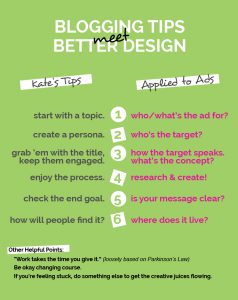Weekly, the genOn staff holds an intern meeting called “Lunch and Learn.” Being that I’m the only design person in the office, the topics of learning aren’t always as applicable to my area of study as they are to the other young ladies I work with. Some of the topics include grant writing, data, and event management. While those are extremely practical for the future non-profit managers that the other interns are, they’re not really the top things on a designer’s “to learn” list. One of the meetings, however, was focused on blogging and facilitated by my supervisor, Kate. Kate’s experience with blogging professionally is extensive as she has managed blog posts for 3 companies she’s worked for, but her personal blog also gives her a lot of knowledge. Simply Savory by Kate is her blog dedicated to food and healthy eating (and savory dishes over desserts because she claims she’s horrible at baking). As I listened to the information Kate presented, I realized that blogging is a huge part of online communication and being that I’m in communication design, it does come up on my designer “to learn” list.
Previously, I thought blogging was solely for fun – a place to rant about your day or talk about your favorite things like Julie Andrews sang in the Sound of Music – or for boring business (like a podcast you have to read). But as Kate talked about the kinds of blogs and the different intents of blogging, I realized that my idea of blogging as a professional was very off. While sometimes, blogging professionally is writing seriously, it can also be fun and light. (Kate told us of her friend, a professional travel blogger who wrote an entry titled “How much money I make as a travel blogger… Not that it’s any of your business.”) Realizing this made it possible to apply the rules of blogging to advertising & graphic design.
I quickly put together Kate’s points & how they helped me think of how to better my ads.
I’m hoping that with the few remaining lunch & learn meetings, I can find more ways to apply other office aspects to design life.




Leave a Reply